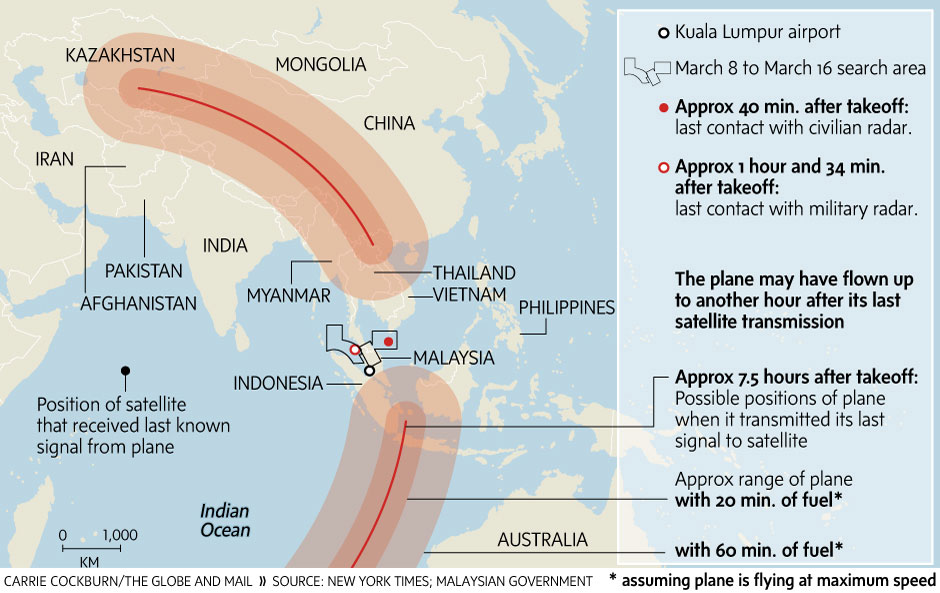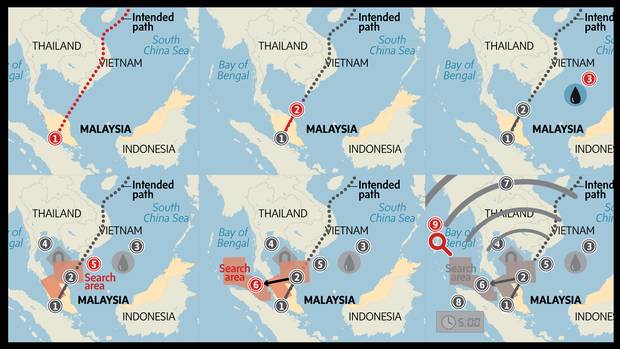
As the search for the missing Boeing 777 jet stretched into a 10th day, two of the nations helping in the hunt, Australia and Indonesia, agreed to divide between them a vast area of the southeastern Indian Ocean, with Indonesia focusing on equatorial waters and Australia beginning to search farther south for traces of the aircraft. To the north, China and Kazakhstan checked their radar records and tried to figure out whether the jet could have landed somewhere on their soil.
Reuters also reported that Chinese authorities have begun searching Chinese territory, focusing on a northern corridor through which the aircraft could have flown.
Malaysian authorities said Monday that the plane's first officer - the co-pilot - was the last person in the cockpit to speak to ground control. But the government added to the confusion about what had happened on the plane by that time, withdrawing its assertion that a crucial communications system had already been disabled when the co-pilot spoke.
Hishammuddin Hussein, Malaysia's Defence Minister and acting transportation minister, had made that assertion Sunday, saying that the jet's Aircraft Communications Addressing and Reporting System, or ACARS, was disabled at 1:07 a.m. Saturday, well before the co-pilot's verbal sign-off. That appeared to point to possible complicity of the pilots in the plane's disappearance.
But Ahmad Jauhari Yahya, the chief executive of Malaysia Airlines, said at a news conference Monday evening that the ACARS system had worked normally at 1:07 but then failed to send its next regularly scheduled update at 1:37 a.m., and could have been disabled at any point between those two times. "We don't know when the ACARS system was switched off," he said.
The new account appeared to reopen the possibility that the aircraft was operating normally until 1:21 a.m., and that the two communications systems failed or were deactivated at the same time, not at separate points. That could raise additional questions about whether the plane was deliberately diverted.
After the ACARS system, the transponder and voice radio contact had all ceased, one device on the plane kept trying to communicate - a satellite transmission device usually used for sending maintenance data. That device kept sending occasional brief signals for several hours after all other contact was lost, Malaysian authorities say; the last signal received from that device indicated that the plane was on or near one of two broad arcs of the Earth's surface. One extends over Indonesia and remote areas of the southern Indian Ocean, the other over the Asian land mass, through western and southwestern China, Kyrgyzstan, Kazakhstan and northern Laos.
Police have been investigating the pilot, co-pilot and other crew members of the missing Malaysia Airlines flight since the day of its disappearance, Malaysia's Transport Ministry said in a statement Monday. The statement highlighted growing interest by law enforcement authorities into whether any of the airline employees might have been complicit in the plane's disappearance.
With a report from Reuters
Source: The New York Times News Service





Big discrepancies, plane flew for 7 hours, cell phones rang well after the flight, one was even answered?
[Link]